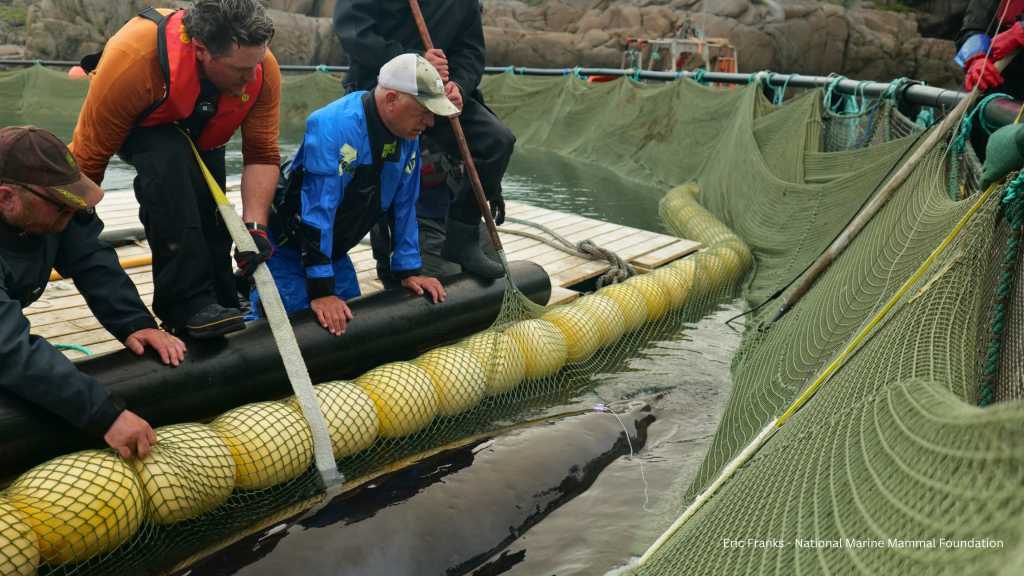Surprising Discovery of Ultrasonic Hearing Sensitivity in Minke Whales will Improve the Conservation and Protection of Baleen Whales Worldwide
This vital data will assist regulators in creating policies that mitigate ocean noise negatively impacting whales.

The multi-national team of scientists leading the groundbreaking study of baleen whale hearing completed its fourth and final season of field operations in Norway this summer. The team’s discoveries will assist ocean noise regulators in developing policy and mitigation practices and facilitate industry and military efforts to minimize negative impacts to baleen whales.
Protection from human-made (anthropogenic) ocean noise is of great importance; six species of baleen whales are currently classified as endangered. Baleen whales rely on sound to communicate, forage, and navigate the world’s oceans.
The team, led by experts from the National Marine Mammal Foundation (NMMF), the Norwegian Defence Research Establishment (FFI), and LKARTS-Norway is committed to the continuous advancement of conservation science to protect whales around the world.
Building upon the knowledge gained last year when the first-ever measures of hearing in baleen whales were successfully collected by this team, this year they measured hearing in two more whales, answering unknowns about their biology and hearing that will directly aid baleen whale conservation.
Vital information
“Until now, no direct measures of baleen whales’ hearing had ever been conducted,” underscored Dr. Dorian Houser, NMMF’s Director of Conservation Biology and one of the project’s lead researchers. “We are incredibly proud to apply our expertise to pioneer methods for safely catching, releasing, and assessing the hearing of these gentle giants. This vital information will help establish scientifically based regulatory guidelines to protect all baleen whales, which is our research’s most important accomplishment.”
“Man-made sound can potentially affect a whale’s hearing, change its behavior, and interfere with its ability to communicate, look for food, and navigate. It can potentially hinder a baleen whale’s ability to hear and avoid ships, and we believe chronically high levels of sound might elevate levels of stress hormones that affect a whale’s health and ability to reproduce,” explained Dr. Petter-Helgevold Kvadsheim, Norway’s lead researcher on the project. “In order to understand if and how whales are affected by anthropogenic noise, scientists and managers need to have knowledge of their hearing ability.”
Can perceive higher frequencies than expected
The scientific team discovered unexpectedly that minke whales can hear frequencies possibly as high as 45-90 kHz. This is higher than previously believed based upon their ear anatomy and the frequencies at which they vocalize. The study also found that the frequency range that minke whales hear best is around 32 kHz. This is no coincidence, Kvadsheim believes. "This overlaps with the same frequencies that killer whales use when hunting with echolocation. Minke whales can be prey for killer whales, so it makes sense that individuals who hear killer whale echolocation frequencies are more likely to survive and pass on their genes."

More secrets to unlock
“There are still more secrets of baleen whales to unlock,” Dr. Houser stressed. Additional data is being gathered on minke whale ecology, as the research team continues to monitor the movement and migration of the whales using satellite tracking technology.
“This study, although challenging, has provided important data to enhance the science that guides the regulatory process to protect baleen whales from increasing underwater sound levels,” said Dr. Frances Gulland, Chair of the Marine Mammal Commission. Their mission is to provide independent, science-based oversight of domestic and international policies and actions of U.S. federal agencies addressing human impacts on marine mammals and their ecosystems.
The research is funded by the Office of Naval Research, Bureau of Ocean Energy Management, National Oceanic and Atmospheric Administration’s National Marine Fisheries Service, US Navy Living Marine Resources, and the Marine Mammal Commission through the Subcommittee on Ocean Science and Technology Interagency Working Group on Ocean Sound and Marine Life.
Published in Science
The landmark discovery has been published in one of the leading scientific journals, Science, making it widely available to scientists, conservationists, and federal regulatory agencies. The method used to temporarily catch and release the whales for hearing measurements was described in a paper published in Aquatic Mammals Journal earlier this year. More about the project can be found here and here.
More information, including a copy of the Science paper, can be found online at the Science press package at https://www.eurekalert.org/press/scipak/.



